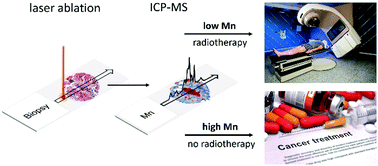Distributions of manganese in diverse human cancers provide insights into tumour radioresistance†
Abstract
Many cancers are variably resistant to radiation treatment: some patients die within months, while others with the same tumour type and equivalent radiation protocol, survive for years. To determine why some tumours are radiosensitive, while others return after radiotherapy, requires new non-traditional approaches to oncology. Herein we used laser ablation-inductively coupled plasma-mass spectrometry (LA-ICP-MS) to test the hypothesis that Mn functions as a metabolic radioprotector and is an apex predictor of tumour radioresponsiveness. The genesis of this hypothesis lies in microbial and in vitro chemical systems. We measured the levels and spatial distributions of Mn in tissue sections of 7 specifically chosen tumour types with distinct clinically documented radioresponsiveness and patient outcomes, namely testis, lung, brain, skin, mesothelium, prostate and breast. Mn levels varied nearly 60-fold between individual tumours, from 0.02 μg g−1 to 1.15 μg g−1. The most radiosensitive cancer type, (testis), had the lowest Mn levels and the highest patient survival. Tumours at the radioresistant extreme (glioblastomas and melanomas) had the highest Mn levels and lowest patient survival. A direct association was found between total Mn contents and their variation, and clinically-inferred radioresponsiveness in each of these 7 tumour types, while no such association existed with Cu, Zn or Fe. The LA-ICP-MS data provided unique patient-specific 2D maps of the spatial metallomic heterogeneity of cancer cells and their stroma. These maps have fundamental and far reaching clinical implications. For the first time, Mn-based tumour data may allow for more precise radiodosages and improved treatment for the individual patient.



 Please wait while we load your content...
Please wait while we load your content...